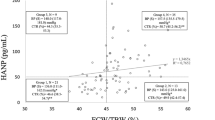Abstract
Objectives
Management of hyponatraemia depends crucially on accurate determination of volaemic (hydration) status but this is notoriously challenging to measure in older people. Bioelectrical impedance analysis (BIA) provides a validated means of determining total body water (TBW), but its clinical utility in determining volaemic status in hyponatraemia has never been tested. This study assessed the utility of BIA in the clinical management of hyponatraemia in elderly patients with fragility fractures (EPFF), a group at high risk of hyponatraemia.
Design
Prospective observational study of consenting patients ≥65 years with fragility fractures (N=127).
Setting
University teaching hospital in Scotland.
Participants
Patients ≥65 years with fragility fractures with capacity to consent to participation.
Measurements
BIA and standard clinical examination procedures (jugular venous distension, skin turgor, mouth and axillary moistness, peripheral oedema, capillary refill time, overall impression) were performed daily throughout each participant’s hospital stay. Volaemic status of hyponatraemia was determined by an expert panel using clinical data (history, examination, nursing observations and laboratory tests) blinded to TBW readings. Cohen’s kappa was calculated to assess the level of agreement between the expert panel and both BIA and standard clinical examination measures in determining the volaemic state of hyponatraemia.
Results
26/33 (79%) cases of hyponatraemia had sufficient clinical information to allow determination of volaemic status by BIA. There was moderate level of agreement between BIA and the expert panel, kappa 0.52 (p<.001). All kappa values for standard clinical assessments of volaemic status neared zero, indicating nil to slight agreement.
Conclusion
BIA outperformed all aspects of the standard clinical examination in determining the volaemic status of hyponatraemic EPFF, suggesting it may be useful in clinical practice.
Similar content being viewed by others
References
Soiza RL, Hoyle GE, Chua MPW. Electrolyte and salt disturbances in older people: causes, management and implications. Reviews in Clinical Gerontology 2008 May; 18(2):143–158.
Gankam Kengne F, Andres C, Sattar L, Melot C, Decaux G. Mild hyponatremia and risk of fracture in the ambulatory elderly. QJM 2008 Jul;101(7):583–588.
Soiza RL, Talbot HSC. Management of hyponatraemia in older people: old threats and new opportunities. Therapeutic Advances in Drug Safety 2011 February 01;2(1):9–17.
Ayus JC, Moritz ML. Bone disease as a new complication of hyponatremia: moving beyond brain injury. Clinical Journal of The American Society of Nephrology: CJASN 2010 Feb;5(2):167–168.
Tolouian R, Alhamad T, Farazmand M, Mulla ZD. The correlation of hip fracture and hyponatremia in the elderly. J Nephrol 2012 Sep–Oct;25(5):789–793.
Chua M, Hoyle GE, Soiza RL. Prognostic implications of hyponatremia in elderly hospitalized patients. Archives of Gerontology and Geriatrics; 2007 45: 3,253–258.
Shapiro DS, Sonnenblick M, Galperin I, Melkonyan L, Munter G. Severe hyponatremia in elderly hospitalized patients: Prevalence, aetiology and outcome. Intern Med J 2010 August 2010;40(8):574–580.
Hoyle GE, Chua M, Soiza RL. Volaemic assessment of the elderly hyponatraemic patient: reliability of clinical assessment and validation of bioelectrical impedance analysis. QJM 2011 Jan; 104(1):35–39.
Soiza RL, Hoyle GE. Syndrome of appropriate antidiuretic hormone: difficulties with diagnosing syndrome of inappropriate antidiuretic hormone in older people. Intem Med J 2011 March; 41(3):295.
Fenske W, Maier SKG, Blechschmidt A, Allolio B, Störk S. Utility and Limitations of the Traditional Diagnostic Approach to Hyponatremia: A Diagnostic Study. Am J Med 2010 7;123(7):652–657.
Clayton JA, Le Jeune IR, Hall IP. Severe hyponatraemia in medical in-patients: aetiology, assessment and outcome. QJM 2006 August;99(8):505–511.
Tambe AA, Hill R, Livesley PJ. Post-operative hyponatraemia in orthopaedic injury. Injury 2003 May;34(4):253–255.
Olde Rikkert MGM, Deurenberg P, Jansen RWMM, van’t Hof MA, Hoefnagels WHL. Validation of Multi-Frequency Bioelectrical Impedance Analysis in Detecting Changes in Fluid Balance of Geriatric Patients. J Am Geriatr Soc 1997 November;45(11):1345–1351.
Kyle UG, Bosaeus I, Lorenzo ADd, Deurenberg P, Elia M, Gomez JM, et al. Bioelectrical impedance analysis — Part II: Utilization in clinical practice. Clinical Nutrition; 2004.23:6, 1430–1453 126 ref.
Kyle UG, Bosaeus I, Lorenzo ADd, Deurenberg P, Elia M, Gomez JM, et al. Bioelectrical impedance analysis — Part I: Review of principles and methods. Clinical Nutrition; 2004.23:5, 1226–1243 113 ref.
Bussolotto M, Ceccon A, Sergi G, Giantin V, Beninca P, Enzi G. Assessment of body composition in elderly: accuracy of bioelectrical impedance analysis. Gerontology 1999 Jan–Feb;45(1):39–43.
Landis JR, Koch GG. The measurement of observer agreement for categorical data. Biometrics 1977 1977;33(1):159–174.
Gwet, Kilem L. Computing inter-rater reliability and its variance in the presence of high agreement. British Journal of Mathematical & Statistical Psychology 2008 May;61(1):29–48.
Verbalis JG, Goldsmith SR, Greenberg A, Schrier RW, Stems RH. Hyponatremia Treatment Guidelines 2007: Expert Panel Recommendations. Am J Med 2007 11;120(11, Supplement 1): S1–S21.
Hoorn EJ, Halperin ML, Zietse R. Diagnostic approach to a patient with hyponatraemia: traditional versus physiology-based options. QJM 2005 July;98(7):529–540.
Verbalis JG, Barsony J, Sugimura Y, Tian Y, Adams DJ, Carter EA, et al. Hyponatremia-induced osteoporosis. Journal of Bone & Mineral Research 2010 Mar;25(3):554–563.
Hoom EJ, Rivadeneira F, van Meurs JB, Ziere G, Stricker BH, Hofman A, et al. Mild hyponatremia as a risk factor for fractures: the Rotterdam Study. Journal of Bone & Mineral Research 2011 Aug;26(8):1822–1828.
Sandhu HS, Gilles E, De Vita MV, Panagopoulos G, Michelis MF. Hyponatremia associated with large-bone fracture in elderly patients. International Urology & Nephrology 2009;41(3):733–737.
Gosch M, Joosten-Gstrein B, Heppner HJ, Lechleitner M. Hyponatremia in geriatric inhospital patients: effects on results of a comprehensive geriatric assessment. Gerontology 2012;58(5):430–440.
Saeed BO, Beaumont D, Handley GH, Weaver JU. Severe hyponatraemia: investigation and management in a district general hospital. J Clin Pathol 2002 December;55(12):893–896.
Thompson CJ. Hyponatraemia: new associations and new treatments. European Journal of Endocrinology 2010 June 01;162(Suppll):S1–S3.
Author information
Authors and Affiliations
Corresponding author
Rights and permissions
About this article
Cite this article
Cumming, K., Hoyle, G.E., Hutchison, J.D. et al. Bioelectrical impedance analysis is more accurate than clinical examination in determining the volaemic status of elderly patients with fragility fracture and hyponatraemia. J Nutr Health Aging 18, 744–750 (2014). https://doi.org/10.1007/s12603-014-0539-8
Received:
Accepted:
Published:
Issue Date:
DOI: https://doi.org/10.1007/s12603-014-0539-8




